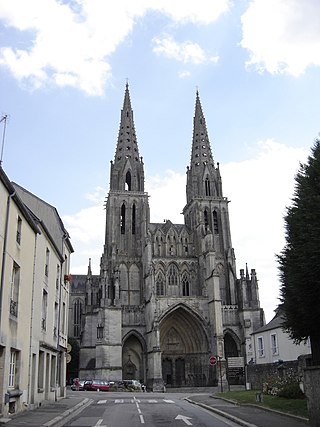Related Research Articles
David Bates is a historian of Britain and France during the period from the tenth to the thirteenth centuries. He has written many books and articles during his career, including Normandy before 1066 (1982), Regesta Regum Anglo-Normannorum: The Acta of William I, 1066–1087 (1998), The Normans and Empire (2013), William the Conqueror (2016) in the Yale English Monarchs series and La Tapisserie de Bayeux (2019).

Sées is a commune in the Orne department in north-western France.
Mauger is a Norman surname of Germanic origin. It was used first as a given name in the Middle Ages. pronunciation API : French [moʒe] ; English [ˈmeɪ.dʒ.ə(ɹ)].
William Bona Anima or Bonne-Âme was a medieval archbishop of Rouen. He served from 1079 to 1110.
This page lists the armoury of the communes in la Manche.

Arcisse de Caumont was a French historian and archaeologist.

Herluin otherwise Hellouin was a knight at the court of Gilbert of Brionne and subsequently a Benedictine monk. He founded the Abbey of Our Lady of Bec, Normandy.
Marc H. Smith is a French historian and palaeographer. Born in Newcastle upon Tyne in England, he has both French and British citizenship.
Pierre Bouet is a 20th-century French historian specializing in Norman and Anglo-Norman historians of Latin language.
Hugh of Eu(Hugues, Hugo) was Bishop of Lisieux from 1049 to 1077.

Bernay Abbey was a Benedictine abbey in Bernay, Eure, France. The designers of its abbey church were ahead of their time, making it one of the first examples of Romanesque architecture in Normandy. It shows the early evolution of that style, its decorative elements and its building techniques.
Bishop Radbod (Radbodus) was a French prelate of the 11th century.
Sigefroi or Sifroi (Sigefridus) was a Norman prelate of the early 11th century in what is today France.
Guillaume Pontifs was a 15th-century French master builder.
Turold de Brémoy was Bishop of Bayeux in the 12th century.
Richard fitz Samson, also known as Richard of Dover, was the bishop of Bayeux at the beginning of the 12th century.
Richard of Gloucester or Richard Fitz Robert was appointed bishop of Bayeux in France in 1138 and died in 1142. He was the eldest son of Robert, 1st Earl of Gloucester, but he was illegitimate. His mother was Isabel of Dover, daughter of Samson of Worcester, Bishop of Worcester.

Montivilliers Abbey is a former Benedictine nunnery, founded between 682 and 684 by Saint Philibert in the town of Montivilliers in Normandy, in the present department of Seine-Maritime, France. It was suppressed during the French Revolution, but many buildings, including the church, have survived.
Raoul d'Avranches (Radulfus) was a bishop of Bayeux at the end of the 10th century and the beginning of the 11th century.
Henri de Pardieu was a bishop of Bayeux at the end of the 12th century (1165-1205).
References
- ↑ Christine Olde-Choukair, L’Architecture normande au Moyen Âge : regards sur l’art de bâtir, t. 1, Luneray, Éditions Charles Corlet; Presses Universitaires de Caen, 2001, 2e éd. ( ISBN 2-84133-135-0 et 2-85480-949-1), « Le chœur de la cathédrale de Sées et l'influence du style rayonnant », p. 159-173.
- ↑ Pierre Bouet et François Neveux, Les Évêques normands du XIe siècle : Colloque de Cerisy-la-Salle (30 septembre - 3 octobre 1993), Caen, Presses universitaires de Caen, 1995, 330 p. ( ISBN 2-84133-021-4), « Les évêques normands de 985 à 1150 », p. 19-35.
- ↑ Christine Olde-Choukair, L’Architecture normande au Moyen Âge : regards sur l’art de bâtir, t. 1, Luneray, Éditions Charles Corlet; Presses Universitaires de Caen, 2001, 2e éd. ( ISBN 2-84133-135-0 et 2-85480-949-1), « Le chœur de la cathédrale de Sées et l'influence du style rayonnant », p. 159-173.
- ↑ Pierre Desportes, Jean-Pascal Foucher, Françoise Loddé et Laurent Vallière (préf. Hélène Millet), Fasti Ecclesiae Gallicanae 9 Diocèse de Sées : Répertoire prosopographique des évêques, dignitaires et chanoines des diocèses de France de 1200 à 1500, Turnhout, Brepols, 2005, 193 p. ( ISBN 2-503-51823-0), « Notice institutionnelle : Le siège épiscopal », p. 6.
- ↑ David Douglas (trad. Marie-Liliane de Bouard), « Les évêques de Normandie (1035-1066) », Annales de Normandie, mai 1958, p. 87-102.
- ↑ Pierre Bouet et François Neveux, Les Évêques normands du XIe siècle : Colloque de Cerisy-la-Salle (30 septembre - 3 octobre 1993), Caen, Presses universitaires de Caen, 1995, 330 p. ( ISBN 2-84133-021-4), « Les évêques normands de 985 à 1150 », p. 19-35.
- ↑ Christine Olde-Choukair, L’Architecture normande au Moyen Âge : regards sur l’art de bâtir, t. 1, Luneray, Éditions Charles Corlet; Presses Universitaires de Caen, 2001, 2e éd. ( ISBN 2-84133-135-0 et 2-85480-949-1), « Le chœur de la cathédrale de Sées et l'influence du style rayonnant », p. 159-173.
- ↑ Christine Olde-Choukair, L’Architecture normande au Moyen Âge : regards sur l’art de bâtir, t. 1, Luneray, Éditions Charles Corlet; Presses Universitaires de Caen, 2001, 2e éd. ( ISBN 2-84133-135-0 et 2-85480-949-1), « Le chœur de la cathédrale de Sées et l'influence du style rayonnant », p. 159-173.
- ↑ Pierre Bouet et François Neveux, Les Évêques normands du XIe siècle : Colloque de Cerisy-la-Salle (30 septembre - 3 octobre 1993), Caen, Presses universitaires de Caen, 1995, 330 p. ( ISBN 2-84133-021-4), « Les évêques normands de 985 à 1150 », p. 19-35.
- ↑ Notice abrégée sur les évêques de Séez, Jules Valin, Sées, 1844.
- ↑ Pierre Bouet et François Neveux, Les Évêques normands du XIe siècle : Colloque de Cerisy-la-Salle (30 septembre - 3 octobre 1993), Caen, Presses universitaires de Caen, 1995, 330 p. ( ISBN 2-84133-021-4), « Les évêques normands de 985 à 1150 », p. 19-35.